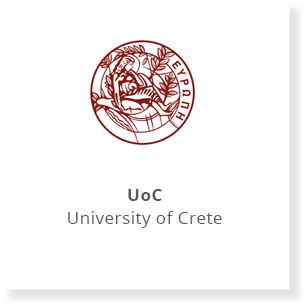EDUCATION
2019: International Diploma in Business Administration (ELKEDIM. Lifelong LC, Greece)
2012: PhD in Structural Biology and Protein Biomaterials (UoC, IMBB-FORTH - Greece)
2007: M.Sc. in Protein Biotechnology (UoC-Greece)
2005: Diploma Degree in Biochemistry and Biotechnology (UoT-Greece)
WORKING EXPERIENCE
May 2016 – Now: Post-Doctoral Researcher at I.M.B.B.-F.O.R.TH, Greece
(Laboratory of Structural Biology)
Nov. 2012 – Apr. 2016: Experienced scientist position at I.M.B.B.-F.O.R.TH, Greece
(InnovCrete project /FP7-Regpot program)
Sept 2019 – Now: Autonomous teaching and exam organizing of the under-graduate courses
"Enzymatic Biotechnology" and “Protein Engineering” at the Dept. of
Biology of the Uni. of Crete
Oct. 2006 –Jan. 2007: Laboratory Teaching Assistant of Microbiology Teaching Lab
at the Dept. of Biology, Uni. of Crete
SELECTED PUBLICATIONS
Mermigka G, Amprazi M, Mentzelopoulou A, Amartolou A, Sarris PF (2020) Plant and Animal Innate Immunity Complexes: Fighting Different Enemies with Similar Weapons. Trends Plant Sci. 2020 Jan;25(1):80-91
Kefala K., Kotsifaki D., Providaki M., Amprazi M. and Kokkinidis M. (2017) Expression, purification and crystallization of a protein resulting from the inversion of the amino-acid sequence of a helical bundle. Acta. Cryst F, 73(1), 51-53
Amprazi M., Kotsifaki D., Providaki M., Kapetaniou EG., Fellas G., Kyriazidis I.,Perez J.and Kokkinidis M. (2014) Structural plasticity of 4-α-helical bundles exemplified by the puzzle-like molecular assembly of the Rop protein. PNAS. 111(30): 11049-54
Ambrazi M., Fellas G., Kapetaniou EG., Kotsifaki D., Providaki M. and Kokkinidis M. (2008) Purification, crystallization and preliminary X-ray diffraction analysis of a variant of the ColE1 Rop protein. Acta Cryst. F 64: 432–434
SCΗOLARSHIPS, AWARDS and GRANTS
Grant "Support for Researchers, with Emphasis on Young Researchers" of the Ministry of Education's Education and Lifelong Learning Program (40.600 euro) (2018)
Short-Term Fellowship by FEBS (2.000 euro) (2012) and Short-Term Fellowship by EMBO (9.000 euro)(2011)
Scholarship “HRAKLEITOS II” for perusing a PhD of the Hellenic Ministry of Education, co-funded by (ESF) & National Source (45.000 euro) (2009-2012)
RESEARCH PROFILE
Being in a Structural Biology group since 2006, Maria Amprazi has studied deeply the protein folding problem, elucidating the relation between amino acid sequence and structural properties of α-helical bundles. The knowledge obtained was used for protein design leading to bio-derived materials for bio-medical applications.
Notable achievements include:
The elucidation of the protein folding pathway of the α-helical protein Rop that is used as a canonical paradigm of this structural motif.
Protein design of novel protein-based biomaterials with specific engineered properties.
Design and production of protein scaffolds that lead to restriction enzymes with new specificities, finding great application in gene therapy.




